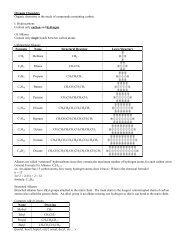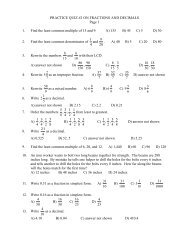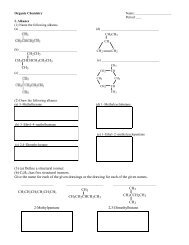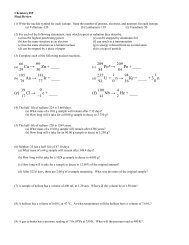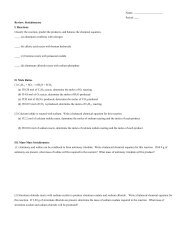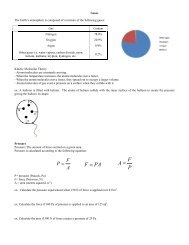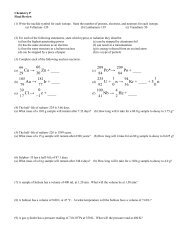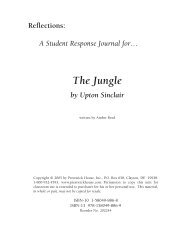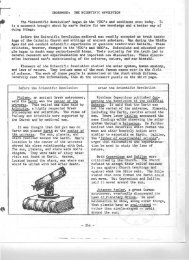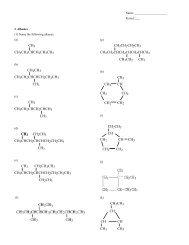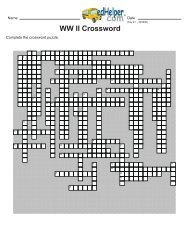- In FDR’s second term, however, the momentum of the ND started to fizzle out – partially b/c of FDR’s ownactions, like the whole Court-Packing fiasco – FDR tried to use the Judiciary Reorganization Bill (1937)to allow him to add judges when old ones failed to retire (he wanted ND judges). But there was too muchopposition and he had to settle w/providing pensions to retiring judges to encourage them to leave.- Another problem was the “relapse” of 1937 – 1939, which was partially caused by FDR’s retightening ofcredit and cutbacks on federal spending. After that, FDR soon resumed deficit spending. Still, the ND wasthreatened in 1937/1938 as people suggested diverging paths for reform. And, in the end, FDR simply chosedeficit financing to stimulate demand, and then dropped off on reforming around 1939 w/the war.- The last important ND acts were: National Housing Act (1937), a new Agricultural Adjustment Act(1938), and the Fair Labor Standards Act (1938).*Labor during the Great Depression*- The Wagner Act, which gave workers the right organize unions and bargain collectively, was a big help tothe labor movement, of course, although management still resisted by using the police to intimidate workersand stop strikes.- Another problem was the <strong>com</strong>petition between the AFL (craft unions) and the new industrial unions, whichrepresented all workers in a given industry, skilled or unskilled. Attempts to join the two types oforganizations together failed.- In 1935 John L. Lewis then quit the AFL and formed the Committee for Industrial Organization (CIO),which led to the AFL then suspending the CIO unions, so the two separated totally. The CIO then went on tobe<strong>com</strong>e a very pragmatic, influential organization that relied on new tactics like sit-down strikes.- Management still sometimes resorted to violence, though, like in the Memorial Day Massacre, whichoccurred when strikers in front of the Republic Steel plant in Chicago were shot by the police in 1937.*Racism during the Great Depression*- African <strong>Am</strong>ericans, like the rest of the country, were hurt by the GD, as they were pushed deeper intopoverty and segregation, as black unemployment rates were higher than for whites. Hoover was quiteinsensitive to race issues; he even tried to appoint an SC justice who supported black disenfranchisement.- Scottsboro Trial (1931) – Nine black teens were arrested for throwing white hoboes off a train and werethen accused and convicted (by a white jury) of rape. An SC ruling intervened, but they were still imprisoned.- Organizations like the Brotherhood of Sleeping Car Porters and the militant Harlem Tenants Leaguefought for civil rights and attacked discrimination, but they were for the most part ignored. NAACP lawyers,however, still made some gains in the SC ruling in Missouri ex rel. Gaines v. Canada (1938).- Then, with FDR’s election, blacks generally switched to the Democratic side, mainly b/c of the reliefprograms. FDR also had a “Black Cabinet,” as there had never been so many black advisers before.- Still, FDR didn’t really care for black civil rights (he was also afraid of alienating voters in the South), so NDwelfare programs often ended up excluded blacks from working or receiving aid. These inconsistenciesspurred blacks to seek direct action, as they knew they couldn’t really rely on gov’t support.- March on Washington Movement (1941) – In response to discrimination in the new jobs in the warindustries, Randolph (leader of the porters’ union) came up with a huge march. Afraid it would lead to riots,FDR then promised to outlaw discrimination in war industries in exchange for a cancellation of the march.- Executive Order No. 8802 – In exchange for the cancellation of the march, FDR established the FairEmployment Practices Committee (FEPC).- Native <strong>Am</strong>ericans also were hurt even more by the GD, especially so b/c there had been a 1929 ruling thatlandless tribes couldn’t receive federal aid, so they had to wait until 1931, when the Bureau of Indian Affairswas finally given more money for relief.- Indians actually benefited from the ND approach once it started: In 1934 the Indian Reorganization(Wheeler-Howard) Act restored lands to tribal ownership and outlawed its future division. And finally, underJohn Collier (he ran the BIA during the ND), Indian culture got some respect.- Mexican-<strong>Am</strong>ericans, however, were majorily screwed during the GD b/c no gov’t programs helped themout since they were migratory farm workers. Only the Farm Securities Administration (1937) didsomething by setting up migratory labor camps, but it was too little too late.Foreign Policy in the Interwar Years (1920 – 1941)*1920 – 1930: Independent Internationalism and Idealism*- In the interwar years, there is a great tendency to classify <strong>Am</strong>erican foreign policy as isolationist. It wasn’t.Independent internat’lism is a better description – we kept our independence (unilateralism) but did be<strong>com</strong>einvolved around the world through diplomacy, our economic interests, etc.64
- Although we rejected the League of Nations, which turned out to be quite weak both because we ignoredit and because its members refused to actually use it mediate disputes, Wilsonianism lived on through<strong>Am</strong>erican peace organizations, which were especially popular among women.- Some of the peace associations’ idealistic goals are reflected in a series of treaties/agreements: Washington Conference (1921 – 1922): In a series of conferences, delegates from severalpowers discussed naval disarmament. Three treaties were promulgated establishing ratios ofnaval power – the Five-Power Treaty (battleships, 5:3:1.75 ratio), the Nine-Power Treaty(Open Door China), and the Four-Power Treaty (possessions in the Pacific). However, therewas no limit on other stuff or enforcement clauses. Locarno Pact (1925): Series of agreements that tried to reduce tension between Germanyand France. Kellogg-Briand Pact (1928): Outlawed war. Too bad it didn’t work out.- Additionally, throughout the 1920s Secretary of State Hughes felt that <strong>Am</strong>erican economic expansioncould help promote prosperity worldwide, eliminating the need for war. So the <strong>Am</strong>erican ReliefAdministration delivered food to Europe both to stimulate growth and hopefully stop radicalism.*1920 – 1930: Economic/Cultural Expansion and the Great Depression*- Following WWI, the US was a creditor nation and the financial capital of the world. In addition to giving uspower internationally this made it easier for us to spread our culture – Coca-Cola, movies, mass-production,and so on.- The government helped the process of US economic and cultural expansion along… Webb-Pomerene Act (1918): Excluded <strong>com</strong>panies set up for export trade from antitrust laws.Edge Act (1919): Allowed <strong>Am</strong>erican banks to open foreign branches.The Dept. of Commerce also took it upon itself to gather information abroad. Foreign loans by<strong>Am</strong>erican investors were also encouraged.- Europeans watched nervously, and were just a little pissed about the US handling of WWI debts, which itinsisted on collecting in full.- The big issue really lay with Germany’s huge bills, which it began defaulting on due to inflation. US bankersthen loaned money to Germany, which went to the Allies, and then back to the US. The Dawes Plan (1924)increased the cycle by providing more loans and reducing the yearly repayment.- Then in 1928/1929, <strong>Am</strong>ericans stopped investing abroad and concentrated more on the stock market athome. The Young Plan (1928) reduced Germany’s reparations but was too little too late.- The Great Depression brought the world economy to a standstill, and when Hoover declared a moratoriumon payments in 1931, hardly any of the money had been repaid. Annoyed, we passed the Johnson Act(1934) forbidding loans to gov’ts not paying back.- As the depression got worse, we exacerbated international problems by upping tariffs: Fordney-McCumber Act (1922) and Hawley-Smoot Act (1930). World trade declined, hurting all involved.- Finally, in 1934 we passed the Reciprocal Trade Agreements Act, which empowered the president toreduce tariffs through special agreements with foreign countries (most-favored-nation-principle entitled us tothe lowest tariff rate set by any nation with which a friend nation had an agreement).- The Export-Import Bank (1934) also helped things along by providing loans to foreigners for the purchaseof <strong>Am</strong>erican goods. In the long term, this stimulated trade and so forth. Still, in the short term, even the neweconomic programs had only mixed results. Uh oh…*1920 – 1930: US Hegemony in Latin <strong>Am</strong>erica*- In the early 20th century, we had majorily gotten involved in Latin <strong>Am</strong>erica through the Platt <strong>Am</strong>endment(Cuba, all treaties must have US approval, US basically controls gov’t), the Roosevelt Corollary (US aspolice power), the Panama Canal, and so on.- This only increased after WWI, when we became involved in numerous aspects of Latin <strong>Am</strong>erican life.Basically, we built stuff, changed tariff laws, invited <strong>com</strong>panies in, and got rid of people we didn’t like, amongother things. We occupied (at one time or another) Cuba, DR, Haiti, Panama & Nicaragua. PR was a colony.- Criticism of our domination, however, also increased in the interwar years. Some charged that presidentswere taking too much power in ordering troops abroad w/o a declaration of war, and business peopleworried that LA nationalists would get mad at their products too. And then talk about a double standard…- Consequently, in the interwar years we shifted from military intervention to other methods: Pan-<strong>Am</strong>ericanism, support for local leaders, training nat’l guards, economic/cultural power, etc. E/t this didn’tstart w/him, FDR wrapped it up nicely in 1933 by calling it the Good Neighbor Policy (nice imperialism).- In order to avoid having to use our military power, we trained people to do it for us (nat’l guards) andsupported dictators [“He may be a SOB, but he is our SOB” – FDR]…65
- Page 3 and 4:
Congregationalists (Puritans) - The
- Page 5 and 6:
- So the Restoration Colonies, form
- Page 7 and 8:
- So in England, where they were lo
- Page 9 and 10:
*Colonial Politics 1700-1750: Relat
- Page 11 and 12:
- Another ideology that was beginni
- Page 13 and 14: - The Quebec Acts were passed aroun
- Page 15 and 16: - So, by 1782, what had seemed to b
- Page 17 and 18: on the economic side, since the gov
- Page 19 and 20: - Anyway, Congress had several ques
- Page 21 and 22: - Adams was still in the early Wash
- Page 23 and 24: *Political Factionalism and Jeffers
- Page 25 and 26: - Samuel Slater set up the first te
- Page 27 and 28: - Court rulings extended the powers
- Page 29 and 30: Revival, Reform and Politics during
- Page 31 and 32: - Anyhow, during his administration
- Page 33 and 34: TEXAS (Southerners) - Texas had bee
- Page 35 and 36: - Anyhow, Pierce’s total support
- Page 37 and 38: They had a smaller everything: smal
- Page 39 and 40: - The two Northern victories at the
- Page 41 and 42: - The result was the Fourteenth Ame
- Page 43 and 44: The Slaughter-House Cases (1873) -
- Page 45 and 46: in the arrest of 8 immigrant radica
- Page 47 and 48: case (1897 - ICC can’t set rates)
- Page 49 and 50: - The Populists prepared to run aga
- Page 51 and 52: - MOST IMPORTANTLY, though, was the
- Page 53 and 54: - So, what led the US to undertake
- Page 55 and 56: - The rebellion, led by Emilio Agui
- Page 57 and 58: - Still, Americans managed to turn
- Page 59 and 60: - So - the point of this episode? B
- Page 62 and 63: *Hoover’s Response*- Poor Herbert
- Page 66 and 67: Dominican Republic - When we left i
- Page 68 and 69: World War II (1941 - 1945)*The Cour
- Page 70 and 71: - So Truman started off again all c
- Page 72 and 73: - First of all, the 1950s were (for
- Page 74 and 75: peace w/Japan that ended occupation
- Page 76: - France wanted out, so at the Gene



